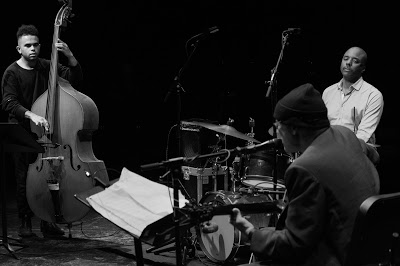By Paul Acquaro
The evening of Jazzfest Berlin’s final night began with a lively duo with guitarist Florian Sotffner and percussionist Paul Lovens, and ended with a passionate set from Marc Robot, between which we experienced a uniquely Berlin ‘fungus’ opera and the holistic sound world of Antony Braxton.
 |
| Photo by Cistina Marx |
The opening event was the awarding of the Deutsche Jazzunion’s Albert-Mangelsdorff-Preis to the legendary German percussionist Paul Lovens, known for his work with, well, just about everyone, and notably with the Schlippenbach Trio and the Globe Unity Orchestra. This evening, Loven’s was introduced by trumpeter Nikolaus Neuser, singer Anette von Eichel, and trumpeter Manfred Schoof. After accepting the award, Lovens engaged in a lively set with guitarist Florian Stoffner. Approaching his guitar Derek Bailey-like, Stoffner was a noisy foil for the nimble Lovens. The two parried through several short improvisations that verred from probing to spiky. After their set (which, if you ask me, could have gone on much longer), Lovens dug from his drum case a pair of his shoes that he had been playing with since 1964 – which were captured photographer Ziga Koritnik’s icon photo.
 |
| Photo by Cristina Marx |
Next, moving into the main hall, was the Berlin based Kim Collective’s “Mass Of Hyphae – a KIM Collective Fungus Opera Creation.” The opera was certainly a sensory experience with events triggering other events, lights, and sounds. The “opera” began with a sudden appearance of the musicians from within and throughout the audience. Running about, bumping into the walls, an emitting monosyllabic sounds, they eventually collected in the center of the room, picked up their instruments and launched into a solidly rhythmic, modal piece. From there, madness ensued. Focus shifted to singer/dancers using the whole auditorium as their base of operations, while video of microscopic fungi, exercise videos from the 1980s, and scientific films from the 1950s played. The night ended with a giant mushroom growing from the floor to the ceiling. Trying to make sense of the opera was futile, but surrendering to the use of lights, projection, space, and perspective, it was one of the more unusual ‘jazz fest’ experiences, and for the collective, an big upgrade from their performance in a space under the stage last year: truly coming up from the earth.
 |
| Photo by Cristina Marx |
Composer, woodwind player, and musical inventor, Anthony Braxton, was up next. Guided by hand gestures and a graphical score, the unique grouping, consisting of two harpists, an accordionist, tuba player, violinist, and second saxophonist Ingrid Laubrock, improvised via guidelines set forth by the composer. The charts are works of art themselves and another part of Braxton’s musical theory – the 11th category to be precise, “gradient formings”. What this mean to the audience however was a collage of visceral musical textures and connections. While at times a bit developmentally static, the overall effect was enveloping (see Alexander’s excellent description of the event as well). The focus shifted from musician to musician to small groupings to the full ensemble, it an ever shifting collage of sounds and when Braxton reached for the bass saxophone, I admittedly got giddy – what a great instrument! During the short pause between sets that followed, not one person I spoke to had left the room disappointed.
 |
| At Soundcheck. Photo by Cristina Marx |
Rounding out the evening was guitarist Marc Ribot and his new quartet. The fiery guitarists most recent recording is a set of protest songs, protesting the current madness and right-wing corruption hanging like a cloud of toxic smog over the US, and this current quartet was a new outgrowth of that music. Fusing his protest songs, “How to Walk in Freedom” and “We are Soldiers in the Army” with with his avant-rock leanings (think Ceramic Dog with a polished saxophonist) and his joyous Latin inflected music, this new quartet with saxophonist Jay Rodriguez, drummer extraordinaire Chad Taylor, and upright bassist Nick Dunston, brought the evening – and festival – to a rousing close. Dunston is someone to watch out for – matching the guitar master in energy and snarl, his solo moments were overflowing with overtones, undertones, and other tones.
The Festival’s mixture of master classes, discussions, film viewings, along with the main events make for a musical experience of serious depth, and the extension of the festival into the city is a nice touch. Beginning this year with the staging of Braxton’s Sonic Genome at the stately Gropius Bau museum in the middle of the city, to the “Kiezkonzerte” (neighborhoods in Berlin are called Keiz) where musicians played intimate gigs at businesses and homes, to the inclusion of local clubs like Quasimodo and A-Trane, and local musicians like the Kim Collective, there is a lot to take in. As someone, in a conversation, somewhere, remarked “this isn’t the Nils Landgren festival anymore.”


